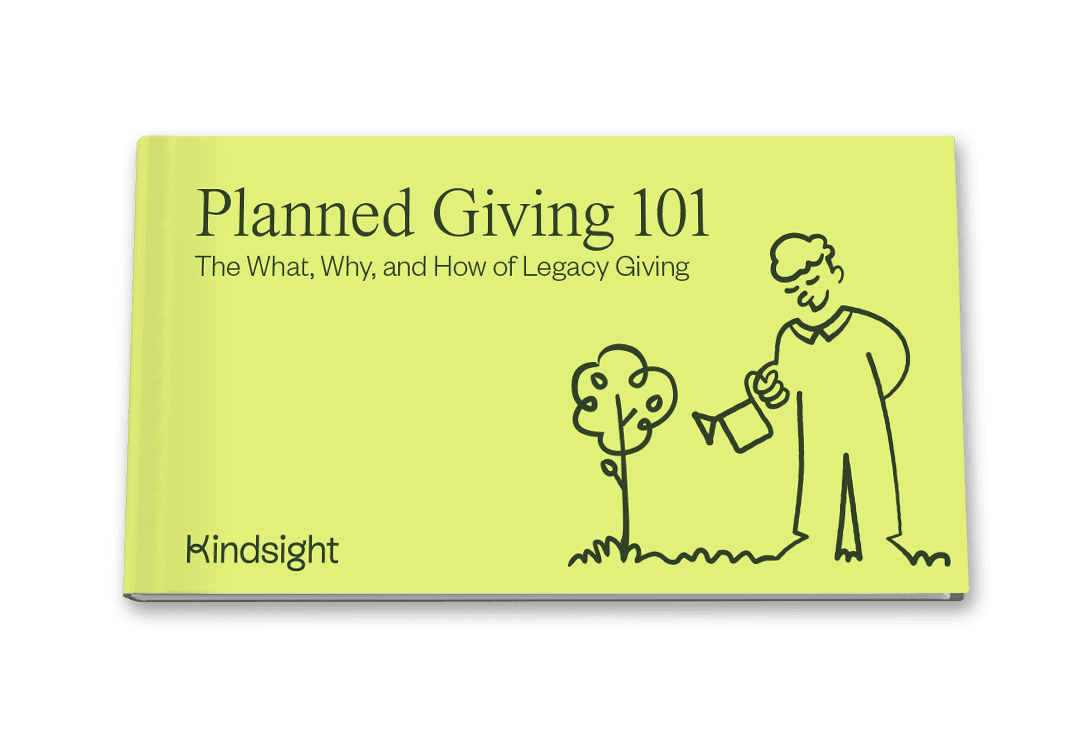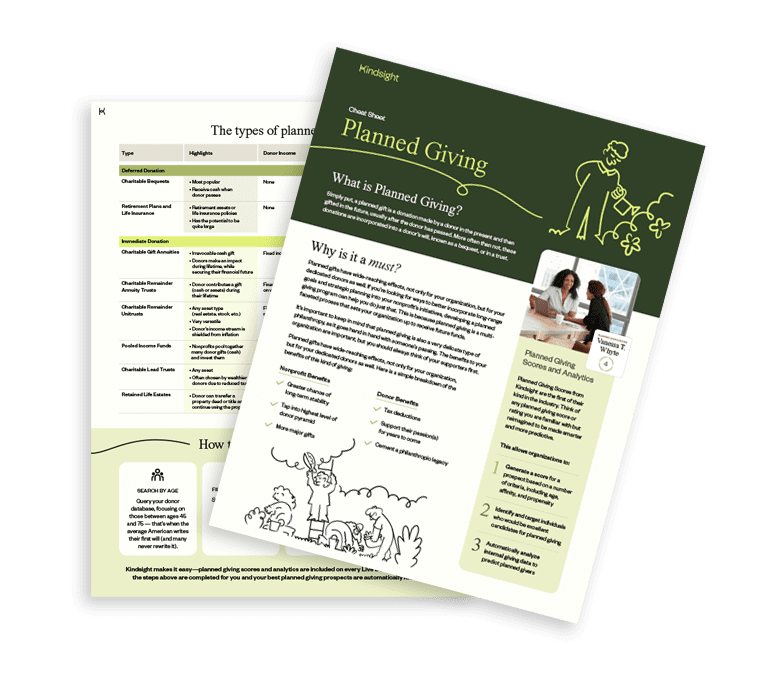
Planned giving is a powerful strategy for increasing your success with nonprofit fundraising. Planned giving donations are typically much larger than annual or even major gifts, although you won’t know exactly when you will receive them or exactly how much they will be.
Any registered nonprofit organization can implement a successful planned gift program with expert guidance and the right software tools. Let’s see how charitable organizations—from large to small—can leverage planned giving to enhance their current fundraising strategies.
What is planned giving?
Planned giving for nonprofits refers to charitable donations that are planned for an unspecified future date. It involves donors bequeathing sizable gifts to nonprofits through financial and estate planning vehicles like a will or trust.
Planned giving funds are either dispersed over time (in the case of a trust) or upon the donor’s passing (in the case of a will). For this reason, the circumstances preceding a planned gift can sometimes be sensitive. Be sure to approach them accordingly.
Planned giving vs legacy giving
It’s important here to distinguish between “planned giving” and “legacy giving” (or “legacy gifts”). “Planned giving” encompasses any kind of giving that is planned ahead of time, whereas “legacy giving” occurs specifically upon the donor’s passing. “Legacy giving” is a subset of “planned giving.”
How planned giving fits into a nonprofit fundraising strategy
Planned giving is one of the most significant sources of income for nonprofit organizations, putting it at the top of the donor pyramid. Planned gifts are often as large as or larger than major gifts, and represent a significant amount of annual revenue for many organizations.
An interesting point to note about planned giving is that it allows typically small recurring or one-time donors to contribute a much larger amount than they could during their lifetime. Including these donors in your planned giving marketing plan in addition to wealthy donors could unlock significant funds that were previously going untapped.
Are you ready for the “great wealth transfer”?
A staggering $30 trillion is set to pass from Baby Boomers in the coming years. Start building your planned giving program today and help donors create legacies that last.

Common types of planned giving
Planned giving can take different forms, determined by the donor’s preference.
1. Bequest
A bequest is a gift left in a will for a group, organization, or individual. For charities, this normally takes the following forms:
- General bequests: Property taken from the assets of an estate. This can be a specific gift amount or a percentage.
- Demonstrative bequests: Gifts from a source like a bank account or stock portfolio.
- Specific bequests: Personal property like cash, jewelry, artwork, antiques, and other tangible assets.
- Residuary gifts: Gifts from the remainder of any debts or expenses that must be paid.
Bequests are the simplest and most popular type of planned giving, and also the most accessible for donors of any income level. They are the best place to start when commencing a planned giving program for the first time.
Bequests and non-probate assets
Non-probate assets, such as retirement accounts, life insurance policies, or assets held in a trust or joint tenancy, cannot be bequeathed in a will. However, these assets can be donated by updating the ownership agreements or designated beneficiaries to include your nonprofit organization.
Bequest intention notifications
Donors are not obligated to notify you of a bequest. They can just write you into their wills and you’ll receive a gift upon their passing. However, unannounced planned giving makes prospects hard to identify since you’re not able to figure out how many donors are a part of your planned giving program.
It’s a good idea to ask planned donors for a bequest intention, which is a written promise that your organization will be included in the will. This can be a simple promise or include more specific details such as percentage amount.
2. Charitable gift annuity
A charitable gift annuity is an agreement between a donor and a nonprofit organization in which the donor transfers assets to the organization. The nonprofit sends regular payments to the donor and/or other beneficiary from the fund until they die, and then keeps the remaining assets.
Charitable gift annuities provide tax deductions for the donors and potentially significant funds for the nonprofit organization. Keep in mind that the agreement must comply with all of the applicable laws in the states where both the organization and the donor are located.
3. Charitable trust
A trust is a legal entity in which an individual holds or invests property as the owner. Upon their death, the trust is usually divided among multiple beneficiaries. The person who transfers assets to the trust is referred to as the “trustor,” “grantor,” or “benefactor.”
The four different types of charitable trusts you’ll encounter include:
- Charitable remainder trust: A charitable remainder trust is a tax-exempt trust created to reduce taxable income by dispersing earnings to noncharitable beneficiaries over a specified period. The remainder is then given to one or more charities of the trustor’s choosing.
- Charitable remainder annuity trust: A charitable remainder annuity trust pays out a fixed percentage of the initial value of the assets held to the beneficiary (the trustor) during their lifetime or a set number of years (up to 20 years). The remainder is then donated to one or more charities of the trustor’s choosing. No assets can be added or withdrawn after the trust is established.
- Charitable remainder unitrust: A charitable remainder unitrust is similar to a charitable remainder annuity trust except that additional contributions can be made after the trust is created. The value of the trust is calculated at the beginning of each year as the basis for percentage-based distributions during that year.
- Charitable lead trust: The inverse of a remainder trust, this trust provides financial support to multiple causes over a set period of time. After this time period, the remainder of the trust is given to the noncharitable beneficiaries—usually family members.
4. Retained life estate
Retained life estate is an alternative strategy to donating real estate outright. In this arrangement, the donor makes the charity a joint legal owner or “remainderman” of their property. They then continue to use the property until their death as the “life tenant,” at which time ownership of the property passes automatically to the charity.
Want even more information about planned giving types?
Discover key insights, donor benefits, and actionable steps to identify top planned giving prospects.

Benefits of planned giving for nonprofit organizations
There are many benefits of planned giving for nonprofit organizations:
- Highest ROI of all giving types: Planned gifts typically have the highest ROI of all types of nonprofit revenue because they are significantly larger (on a per-gift basis) than what most people give in one-off or recurring donations.
- Potentially significant source of funds: The financial impact of a planned gift is typically much larger than that of a loyal donor’s monthly or annual donation.
- More eligible donors: Planned giving is accessible to people of all income levels because it’s based on a percentage of the donor’s saved assets rather than a fixed dollar amount.
- Diversified revenue streams: The more revenue streams your nonprofit has, the more resilient your organization will be in the event of an economic downturn or change in giving patterns.
- Stronger relationships with donors: Planned giving strengthens donors’ relationships with nonprofits because it represents a long-term commitment. It’s essential to properly steward your donors to maximize these benefits and ensure the planned gift comes to fruition.
- Increases other types of giving: Donors with a charity in their will give twice as much in annual donations as those who do not (page 19 of the PDF).
Benefits of planned giving for donors
Primary benefits of planned giving for donors include:
- Create a legacy: Planned giving allows dedicated supporters to leave a lasting impact on a cause they care about.
- Tax advantages: Planned giving provides various opportunities for saving on estate and/or capital gains taxes, depending on the type and timing of the gift. It’s best to advise interested individuals to consult with a tax professional regarding the planned giving strategy that would be most tax-effective in their case.
- Opportunity to designate the purpose of the funds: Planned gift donors can specify how they would like a planned gift to be used (within the scope of the organization’s work). They don’t typically have this opportunity when making one-off, monthly, or annual donations.
Tip: Maximize the impact of these advantages in your program with our dedicated article on Planned Giving Benefits.
How to start a planned giving program
A formal planned giving program will help you uncover potential new supporters and ensure everyone is well informed about the specifics so the donation process goes smoothly. There are a few steps you need to take to incorporate a planned giving program into your nonprofit’s strategy:
- Research planned giving thoroughly: Begin by researching planned giving in detail. You should also consider your organization’s readiness to accept planned gifts before moving forward.
- Build a planned giving team: You will need a solid team behind you to make your planned giving program successful. This team should include a planned giving officer, a marketing specialist, a gift administration specialist, and a database manager.
- Identify prospective donors: Identify several potential planned giving donors using prospect research, ideally using an intelligent prospect research tool, before pitching the idea to your organization’s leadership. This will help you gauge how viable the idea is (in terms of resource allocation) and help you develop a strong case to present to the board.
- Form an advisory committee: Your planned giving team will need an advisory committee to keep you organized and on track, help you develop procedures and policies (including gift acceptance policies), and provide guidance when issues or concerns arise.
- Create a plan: Meet with the planned giving team and draw up a plan for how the program could work in your organization.
- Approach the board: Schedule a meeting with your nonprofit board to educate the leadership about the benefits of planned giving and present your ideas for a planned giving program.
- Appoint or hire a planned giving officer: Your planned giving officer is the staff member who is solely responsible for the day-to-day operations of the program. You can either appoint a staff member to take on this role or hire an external expert.
- Create a planned giving brochure: Prepare a planned giving brochure to present to interested donors. This brochure should include a moving description of the program, contact details, and your organization’s “case for support.”
- Create a marketing strategy and calendar for the program: Marketing planned gifts involves the creation of a range of print and media resources. You will also need to add a planned giving page and donation option to your website.
- Launch your program: Set an official launch date for your planned giving program. This is the date you will start accepting and processing planned gift notifications from donors.
- Keep communicating: Small but consistent communications today gradually cultivate strong relationships with potential donors to gain gifts in the future.
- Acknowledge and steward planned giving donors: Acknowledge and steward planned giving donors diligently using a nonprofit CRM to make sure no one falls through the cracks.
- Track progress and adjust as needed: Track your progress based on your initial goals and continue to grow and refine your strategy over time.
Ready to get started? Get the full roadmap with our guide on How to start a planned giving program.
Secure your nonprofit’s future with planned giving
Planned giving can propel your organization forward if done well. The beauty of this strategy is that it allows donors of all income levels to make a significant contribution to your cause.
It’s essential to dedicate time to careful research and planning at the beginning to establish a planned giving program that is feasible for your organization and aligned with your goals. The right approach—coupled with the right people and tools—will help you maximize your program’s success.
Be the first to read our resources.
The world is changing quickly—and our resources help you stay on top of it all. Sign up to get new insights, success stories, and more, sent right to your inbox.




